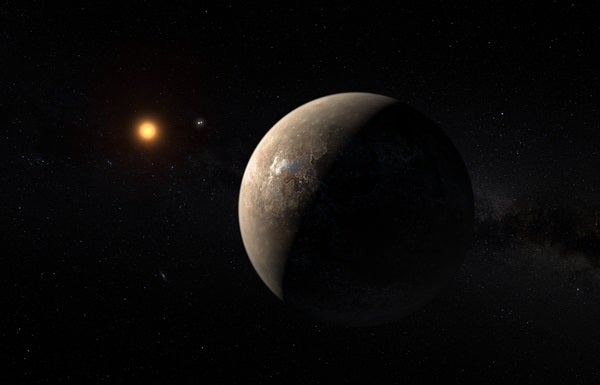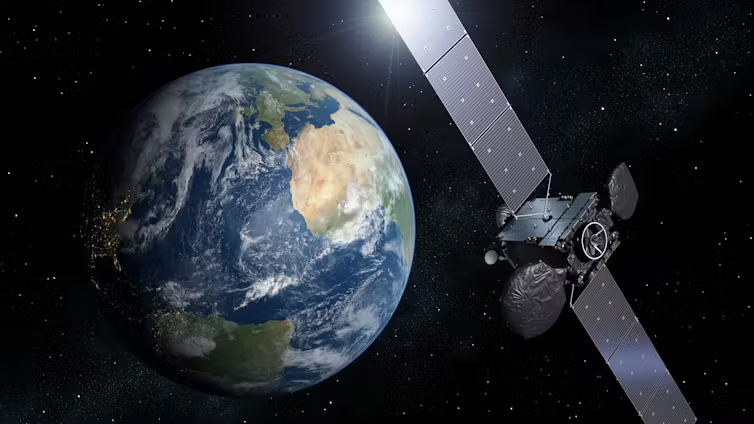A pale red dot not far from our sun may be orbited by a pale blue dot much different than Earth.
In a shocking find, astronomers Wednesday announced their discovery of an Earth-sized planet orbiting the nearest star, Proxima Centauri, just 4.2 light-years away. This warm world, cataloged as Proxima b, sits smack in the middle of its habitable zone — the sweetest of sweet spots — where liquid surface water could exist.
But Proxima Centauri is not like our sun. It’s a cool, low-mass star known as a red dwarf. So the planet only qualifies as potentially habitable because it circles its sun in an orbit tighter than Mercury’s.
Hidden Planet
“The first hints of a possible planet were spotted back in 2013, but the detection was not convincing,” says Queen Mary University of London astronomer Guillem Anglada-Escudéf, who led the discovery team. “Since then we have worked hard to get further observations off the ground.”
Anglada-Escudéf’s group, called Pale Red Dot in homage to Carl Sagan, is an international team of several dozen astronomers who have collectively spent years searching for Earth’s nearest neighbor.

This picture combines a view of the southern skies over the ESO 3.6-meter telescope at the La Silla Observatory in Chile with images of the stars Proxima Centauri (lower-right) and the double star Alpha Centauri AB (lower-left) from the NASA/ESA Hubble Space Telescope. (Credit: Y. Beletsky (LCO)/ESO/ESA/NASA/M. Zamani)
Incredibly, the planet’s ghostly signal was hidden in the data for decades. Pale Red Dot noticed a weak signal reoccurring every 11.2 days. They used this potential find to secure support from the European Southern Observatory, and then they set out on an unprecedented confirmation campaign.
For months earlier this year, they kept a near-constant vigil on Proxima Centauri using ESO’s 3.6-meter telescope at the La Silla Observatory in Chile. Their radial velocity technique, which detects tiny wobbles as the planet pulls on its star, provided the stunning confirmation.
An analysis of this new data, as well as a simultaneous analysis of decades-old observations, was revealed Wednesday in the journal Nature.
“You take the old data and the new data, and you combine everything together, and then the significance of the detection goes sky high — very, very significant,” says Anglada-Escudéf.
In It for the Long Haul
The team went to great lengths to confirm Proxima b because these small suns have a history of fooling astronomers. Red dwarfs are violent stars known to erupt and create signals that look like planets.
Paul Robertson is an astronomer at Pennsylvania State University who was not involved in the Pale Red Dot effort. In addition to searching for planets around low-mass stars, he also studies their strange behavior. He’s shown other habitable zone planet discoveries — including past finds by Anglada-Escudéf — are really just magnetic activity unlike any seen on our sun.

An artist’s conception of the red dwarf star DG CVn. Violent flares are common with these smaller stars.(Credit: NASA Goddard Space Flight Center/S. Wiessinger)
“This is such an important system. These are our next door neighbors,” says Robertson. “A claim of a habitable-zone planet around Proxima is genuinely extraordinary. So you have to go to somewhat extraordinary lengths to make sure you’re right, and I think that’s what they were doing with Pale Red Dot.”
He’s not the only one hailing the discovery as perhaps the most exciting new world yet — and not just because it’s Earth’s nearest neighbor.
“I would say this is the topmost ranked exoplanet if it is confirmed,” says Ravi Kopparapu of NASA’s Goddard Spaceflight Center.
Kopparapu is a leading expert in defining habitable zones using factors like how hot a star is and how much of its light hits the planet. The Pale Red Dot team, and many other exoplanet studies, rely on his calculations.
In recent years, NASA’s Kepler space telescope has turned up thousands of new worlds around all sorts of stars — including small ones with planets in tight orbits, like Proxima. So experts aren’t surprised there’s a planet next door, but they are shocked that this nearby world has a shot at hosting life.
“If confirmed, this will be one of the most significant discoveries to date in the field of exoplanetary science and also for potentially habitable planets,” says San Francisco State astrophysicist Stephen Kane, who chairs the Kepler Telescope Habitable Zone working group.
Kane points out that, “If the star closest to our Sun also has a planet in the habitable zone, then that raises the expectation that other stars will also harbor such planets.”
Red Dwarfs Everywhere
Proxima Centauri is notable because red dwarves are the cosmos’ most abundant type of star. If the Milky Way held just 100 stars — it actually has 100 billion — 75 of them would be these cool, tiny suns.
A recent study in The Astrophysical Journal used Kepler’s exoplanet catalog to predict that just 16 percent of these stars should have Earth-sized planets in their habitable zones. Based on those odds, the nearest habitable worldwould be 20 light-years from Earth. With the discovery of Proxima b just over 4 light-years away, nature showed it still has some surprises.
What’s There?
“We’ve found one right next door,” says Kopparapu. “It’s in the middle of the habitable zone and Earth-size. It has all the things that we can dream of — except we don’t know if it has an atmosphere.”
But even with an atmosphere, Proxima b could still be barren.
The planet’s close-in orbit means it’s tidally locked like the moon is to Earth. Proxima b’s day-side forever faces its sun. And the same constellations we see on Earth shine perpetually on the planet’s night-side.

This artist’s impression shows a view of the surface of the planet Proxima b orbiting the red dwarf star Proxima Centauri, the closest star to the solar system. (Credit: ESO/M. Kornmesser)
“It’s possible the daytime side of the planet would be roiling hot and the nighttime side would be freezing cold,” says Robertson.
But even if Proxima b does have a scorched and frozen side, there’s still a chance for Goldilocks perfect conditions in between those two regions, where the planet would be bathed in permanent twilight.
“It might be like being in Alaska, where you only see the sun peeking out of the sky perpetually,” says Robertson. “That would be the only place that it would be temperate enough to stand there.”
And that’s only the start of the caveats for this terrestrial world. Proxima Centauri is also 100 times more active than the sun, bombarding the planet with ultraviolet and x-ray radiation. The star is about the same age as our own, and if those eruptions were too strong while the planet was forming, it could have wiped away any water.
“Whether there is water or not we do not know,” says Pale Red Dot team member Ansgar Reiners of the German Universität Göttingen. “That entirely depends on the formation, on the history of the planet, and this will be subject to further studies.”
Thankfully, Proxima is perfectly placed for follow-ups. There can be no exoplanets closer.
And the next potential find is already showing itself. There’s a periodic signal that hints a second planet — Proxima c — could be lurking in the data. But they’ll need many more nights at the telescope to be certain it’s not just the machinations of a violent star.
This post originally appeared at Discover Magazine.











